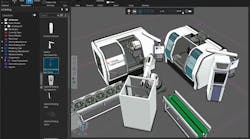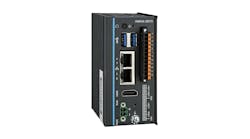Mitsubishi Electric launched the Melsoft Gemini 3D simulator to help manufacturers streamline the design and construction of production facilities. The development of the 3D digital-twin simulation software was driven by factors affecting the current global market and manufacturing customer trends. “The COVID pandemic changed the way we do business in the manufacturing sector,” says Lee Cheung, associate product manager at Mitsubishi Electric Automation. “Travel restrictions and limited on-site work made it difficult for manufacturers to install and maintain production equipment. At the same time, consumer trends are changing faster than ever, requiring manufacturers to make their manufacturing operations more agile and to quickly bring new or different products to market. Melsoft Gemini helps manufacturers adapt to this new environment by accelerating the design and validation of new machines, production lines and modifications, and with less on-site work.”
Also read: Factory simulation is a numbers game
With a digital space to simulate and verify production operations, facility design and construction can be expedited. Melsoft Gemini’s 3D verification of production facilities is designed to make the process easier, starting with the floor plan and where machines and equipment are located. The software can simplify verification through pre-made or custom 3D models with precise dimensions for the layout. Then, a workflow process can be defined and connected to automation control logic, and the entire production process can be simulated. “With this capability, it is possible to see how a production-line design would actually run,” Cheung says. “Then, you can quickly identify line design flaws or bugs in the control logic.”
During the verification process, facility engineers can check the facility status by looking at the PLC sequence program, reviewing displays of operation waveforms and/or video data when an error is found. Flaws or bugs can be addressed earlier in the design phase before they become issues in live systems. Detailed checks for operational interference can also reduce rework and improve overall quality. Some examples of interference checks might be collisions from moving parts on a machine with another object or the ability for a robot to reach a certain point in space, Cheung says. “Especially for higher-speed applications, Melsoft Gemini’s direct connection to controller hardware and simulators matter to make the simulation accurate,” he adds.
Streamlining the manufacturing work processes is possible by connecting to a variety of software and factory devices, aiding the design of production facilities and operation and maintenance of live production. Melsoft Gemini simulates production lines and equipment using a PC-based 3D digital space, and that digital verification can support faster and more simplified launch of the actual equipment and lines during installation.
The software connects to Melsoft simulators, which are available separately as part of the Melsoft iQ Works software package. This simulates device control for PLCs, servo motion controllers and robots. Melsoft Gemini can connect directly to these simulators and other factory devices without having to go through an OPC server, meaning 3D data can be updated in digital spaces approximately 12 times faster than OPC environments. “In an OPC environment, a sensor can fail to detect objects due to communication delay,” Cheung says.
The hardware menu (e-catalog) supports approximately 2,500 types of production equipment, including robots, conveyors and processing machines. These can be combined via drag-and-drop into a 3D production facility, and various parameters can be set to adjust the layout of the 3D production line.
To find the most efficient production line setup, the system can analyze simulation data on different operating rates of production and visualize via line, area, bar and circle graphs. Analysis can also be done for equipment operating status, production-task duration or worker wait time to identify different production yields and operating rates for the best design.
The 3D simulators are designed for users that want to pre-verify line changes to prevent rework or for customers that can’t verify line/equipment defects during operation without visiting sites.
Anna Townshend has been a writer and journalist for almost 20 years. Previously, she was the editor of Marina Dock Age and International Dredging Review, published by The Waterways Journal, until she joined Putman Media in June 2020. She is the managing editor of Control Design and Plant Services. Email her at [email protected].






